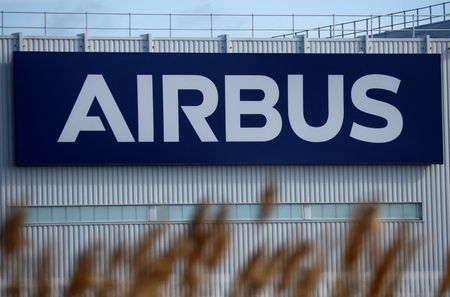By Tim Hepher
PARIS (Reuters) – Airbus received a billion-euro boost in projected cashflow from a strong dollar and said it was exploring higher production to meet resurgent demand for wide-body jets, as the European planemaker celebrated five decades of flight on Friday.
Third-quarter revenue also benefited from the U.S. currency but operating earnings that include hedging rose by a slimmer-than-expected 26% to 836 million euros ($834.5 million) as the company battles a “degraded” global supply chain.
Airbus raised its forecast for free cashflow in 2022 to 4.5 billion euros, from 3.5 billion, after generating almost twice the amount of expected cash in the third quarter.
Analysts were on average expecting quarterly adjusted operating income of 887 million euros on revenues of 12.848 billion, according to a company-compiled consensus.
Chief Executive Guillaume Faury joined French engine maker Safran, also reporting on Friday, in striking a more upbeat note on recently disrupted engine supplies than Boeing which on Wednesday said engines were its main constraint.
Engines are still behind the original schedule but are now being delivered according to commitments, Faury told reporters.
Engine makers have reported problems in obtaining castings from two main suppliers but General Electric said this week main deliveries had risen 50% from the previous quarter.
Taken as a whole, a fractured global supply chain remains a “very degraded environment” following the pandemic, but the situation has “stopped getting worse,” Faury said.
Faury reaffirmed single-aisle production targets and said Airbus was assessing supply chain capacity for an increase in production of wide-body jets. Demand for the industry’s biggest models is recovering after a slump pre-dating COVID-19.
Faury paid tribute to the “pioneering spirit” of designers and builders who brought the world’s first twin-engined wide-body jet, the A300, to a first flight on Oct. 28, 1972.
After a shaky start the then European consortium broke open a U.S.-dominated market, but its commercial success stems mainly from smaller single-aisle jets while its attempt to build the world’s largest airliner, the A380, was hampered by weak sales.
Airbus on Friday delayed the introduction of its latest A321XLR single-aisle jet, to be built in the former A380 factory, to the second quarter of 2024 from early 2024.
($1= 1.0018 euros)
(Reporting by Tim Hepher; Editing by Sudip Kar-Gupta and Stephen Coates)

